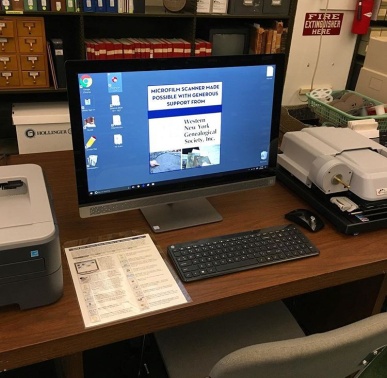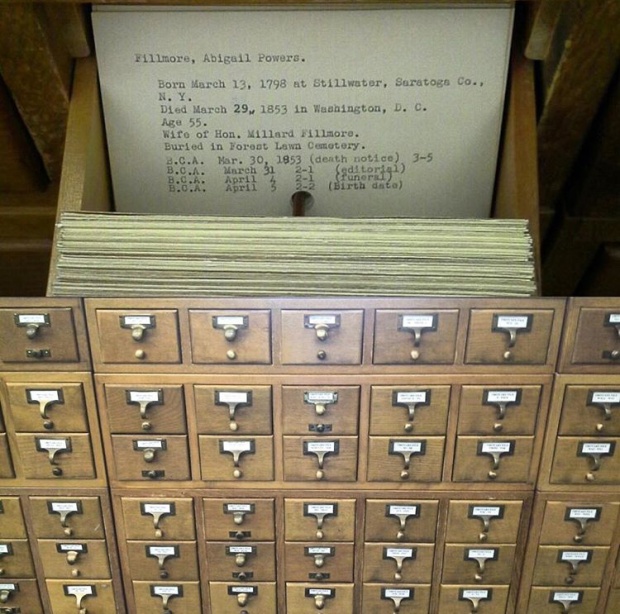If you’re a first-time visitor to the Research Library, it is not immediately apparent what you can do and discover here. So we thought we’d write a list for the neophyte.
1. Look for a relative or ancestor’s obituary. We have a card file with names of people who were listed in obituary columns in Buffalo daily newspapers, 1811-2001. There are about 99,000 names in alphabetical order. While this isn’t every single death reported in almost two centuries of Buffalo newspapers, it is the largest obituary index in Erie County.
 2. Read a newspaper published the day you were born. We have Buffalo newspapers on microfilm from 1811 to about 2011, including Polish and German papers published here. We can get out y
2. Read a newspaper published the day you were born. We have Buffalo newspapers on microfilm from 1811 to about 2011, including Polish and German papers published here. We can get out y
our birthday paper, load it on a microfilm reader-printer, and you can make black & white copies from it for $.25/page.
3. See if we have a picture of the house you grew up in. We have about 30,000 house & building photos from Buffalo & surrounding area. Maybe we have your childhood home or corner store.
4. Figure out where your grandparents lived. If no one can recall for sure where Grandma & Grandpa lived, come on in and consult our Buffalo city directories. We have one for every year from 1828 to 2001, with a few gaps.
 5. Look at Buffalo & Erie County atlases. We have roughly one per decade from 1850 to 1950, with a few gaps. What’s great about them is that they show footprints of individual houses & buildings that used to be there or might still be there today. You can look at them one by one and see when your house first appears, which helps you narrow down when it was built.
5. Look at Buffalo & Erie County atlases. We have roughly one per decade from 1850 to 1950, with a few gaps. What’s great about them is that they show footprints of individual houses & buildings that used to be there or might still be there today. You can look at them one by one and see when your house first appears, which helps you narrow down when it was built.
6. Check our vintage postcards. We have about 8,000 Buffalo picture postcards organized by subject (including many duplicates), plus we have a separate album of about 400 Buffalo cards collected and donated by Phyllis Peyton. Her album is out on a counter for anyone to browse.
7. Use our WiFi. The Museum has free wifi throughout our building. Ask for the log-in at the Front Desk or in the Research Library.
8. Check out our new acquisitions. We are always adding to the collection in one way or another. We purchase Buffalo-related books today that we think will answer questions tomorrow and beyond. Maybe we found something that you didn’t know existed.
9. Look at church records on microfilm. These are important for family history research. New York State did not pass a vital records law until 1880, meaning that there are no government-issued birth certificates, marriage licenses, or death certificates prior to1880. This is where sacramental records come in. We have baptism, marriage, and death records on microfilm from about 180 local congregations, mostly Roman Catholic, Episcopal, and Methodist. Special bonus: we also have some cemetery records on microfilm.
 10. Pick our brains. Got a Buffalo-area history question or research problem and you don’t know where to start? Our expert librarians are on duty whenever the Research Library is open to the public. While we cannot undertake your research for you, we can identify and pull out relevant books, clippings, atlases, pictures, microfilms, or more, to get you started. We don’t always know what the answer is; we know (or work to figure out) where the answer is.
10. Pick our brains. Got a Buffalo-area history question or research problem and you don’t know where to start? Our expert librarians are on duty whenever the Research Library is open to the public. While we cannot undertake your research for you, we can identify and pull out relevant books, clippings, atlases, pictures, microfilms, or more, to get you started. We don’t always know what the answer is; we know (or work to figure out) where the answer is.
The Research Library cares for everything two-dimensional collected by the Museum since 1862, mostly paper-based stuff. This includes books, periodicals, newspapers, letters, diaries, personal papers, postcards, photographs, prints, drawings, scrapbooks, microfilms, atlases, maps, pamphlets, and audio-visual material.
The Library is open Wednesdays through Saturdays, 1:00 to 5:00 pm, plus evening hours on Wednesdays, 6:00 to 8:00 pm. No appointments are necessary. Admission is free for members and $7 for general. Questions? Call us at (716) 873-9644 ext. 306 or email library@buffalohistory.org.
Cynthia Van Ness, MLS
Director of Library & Archives
*This article was featured in the Winter 2016-2017 issue of “The Album,” The Buffalo History Museum’s quarterly newsletter.


